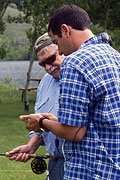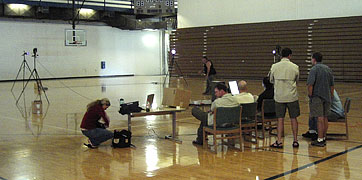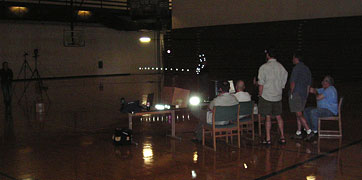by Jason Borger
This is a report looking at the first Fly Casting Institute (FCI) Clinic (June 16-19, 2005), as well as the third session of fly-casting motion-capture (mo-cap) sessions at Montana State University (MSU) in Bozeman, Montana. The third mo-cap session was scheduled as part of the FCI Clinic, and included the casters who attended the Clinic, as well as guest-caster Paul Arden (who was captured to further the study in long-distance casting, as well as for an ongoing archival database).
The FCI Clinic was held at Hubbard's Yellowstone Lodge in Montana's Paradise Valley. The Clinic included casting instruction, video analysis, time on a Casting Analyzer (now the Sage Casting Analyzer), upper extremity physical exams coupled with specific rehab exercises, and a day spent at MSU with the 3-D mo-cap gear. Of course, with Hubbard's trout-filled, 85-acre lake at the Clinic's immediate disposal, there was more to the FCI than just talking fly casting.
|
|
|
(top) The first FCI Clinic group. (bottom left) "Is this thing on?" Tim (left) and myself getting the Casting Analyzer set-up. The Analyzer's immediate feedback in the field (via a Palm handheld computer) makes it a superb teaching tool. (bottom middle) Tim with FCI Clinic participant David Morris, discussing results obtained from the Casting Analyzer. (bottom right) An actual chart produced from the Casting Analyzer. When you know what you're looking for, there is a lot of information contained in those seemingly simple ups and downs. |
The FCI mo-cap session ran on June 18, in a basketball court at MSU's Shroyer Gym. The Shroyer court proved to be darker than Bobcat Stadium used for the January 2005 session (a good thing, but also proved to smaller (that was bad, at least for Paul). None-the-less, this latest session allowed everyone to cast at short to medium ranges, and for Paul to make long-enough casts (shooting the full line) to be very useful for the mo-cap database.
|
|
|
(top) The "casting stage" being tested in a basketball court at MSU's Shroyer Gym as FCI Clinic participant, Mike Isom, prepares to cast. (bottom) Lights off and mo-cap ready to go, with Mike and his fly rod "lit up" by the camera flash. |
The crew for this capture session again included Mike, Tim and myself, as well as physical rehab specialist Justin Hunt (doing rehab work for the FCI) and Mark McCue. MSU graduate student Josh Allen was also on-hand, working with Dr. Hahn and providing the group with a sneak-peek at a comparative casting model built using the mo-cap database and Vicon Polygon software. The FCI Clinic participants are to be among the first in the world to receive casting feedback using the comparative system (update: Josh, Katie O'Keefe, Tim and Mike have recently published an abstract utilizing the January 2005 session data. The PDF can be found here).
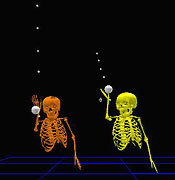 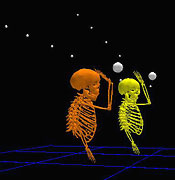 |
|
The comparative system at work. This is all presented in real time with a user-controlled 3-D environment. (left) A caster shown in two views simultaneously. The orange skeleton on the left is the caster "before instruction" and the yellow skeleton on the right is the caster "after instruction." The comparison is that of casting tempo and timing. In the frame shown, the orange caster is ahead of the yellow caster during the casting stroke (orange is partway through the forward cast while yellow is just about to begin the forward cast). The instructional goal was to slow down the casting tempo and timing in order to get the caster to relax and to allow the line to unroll properly on the backcast. The revised tempo and timing of the yellow caster shows that the caster did indeed slow down and relax. (right) Again, this is a caster shown in two views simultaneously. The orange "before instruction" caster is aiming/stopping the rod too far down-and-back, resulting in a loop that is open and aimed more toward the ground. The yellow "after instruction" caster has made a dramatic change (see forearm, wrist and rod positions) and now has a loop that is travelling more up-and-back into the air. |
Prior to the mo-cap session, the FCI Clinic participants had been given focused, upper-extremity physical exams. This, combined with a detailed casting questionnaire, served to further integrate the motion data with each caster's physical history. The data collected will be further used in understanding casting problems from the perspective of injury prevention and rehab, as well as biomechanics.
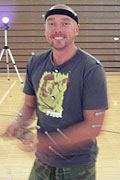 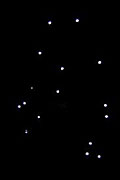 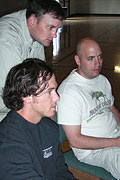 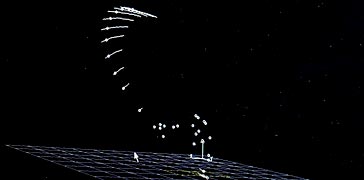 |
|
(top left) Paul Arden rigged and ready to cast. One of the six infrared cameras used for capture can be seen in the background. (top middle) An alternate view of the constellation Ardus Capturon. (top right) "What is he doing?!" Rehab specialist Justin Hunt (background left), Mark McCue (right) and MSU grad student Josh Allen (foreground left) watching the capture PC as Paul casts. (bottom) Paul and his Sage TCR reduced to dots and velocity tracks (the grid is the floor). This is a screen shot of the very end of Paul's cast (at 200 frames-per-second). Such detailed movement is difficult to impossible to assess accurately with "normal" video, but becomes much easier to study with the mo-cap system. Such detail allows more-careful study of hand/arm movements and subsequent alterations in rod flexure and tip path during the very rapid final moments of a long-distance cast. |
I personally did not cast for this session. There were more casting experiments that I wanted to do, but time was short and getting Paul into the database was important. With Paul's capture, we now have access to a further range of extreme distance casts made with off-the-shelf fishing equipment. More to come!
Photos by Jason Borger and Kelley Borger (FCI group photo courtesy of Melody Beutler).
Copyright © Fly Casting Institute. All Rights Reserved.
![]()


